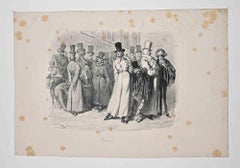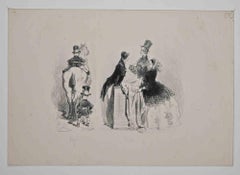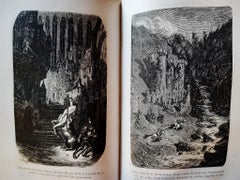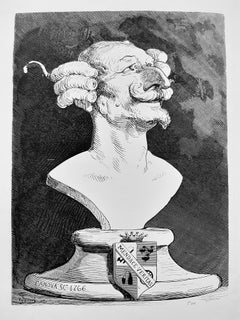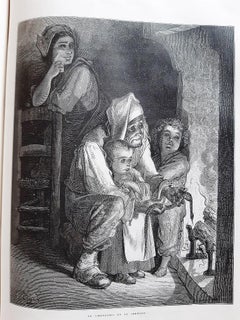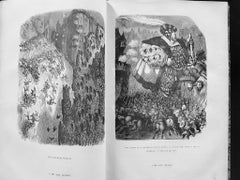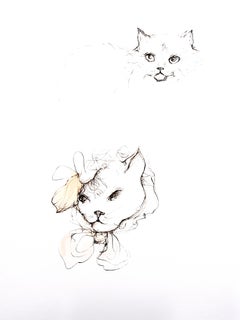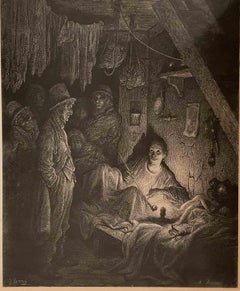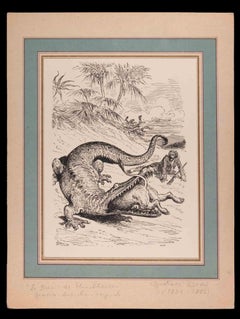Gustave Doré Art
1
to
1
7
1
6
2
8
Overall Height
to
Overall Width
to
7
3
3
3
2
8
15
6,938
3,292
2,514
1,213
3
2
2
2
1
Artist: Gustave Doré
Parisian - Lithograph by Gustave Dorè - 1854
By Gustave Doré
Located in Roma, IT
Parisian is aLithograph realized by Gustave Dore in 1854.
Good conditions except for some foxings.
Hand-singed.
The artwork is depicted in a well-balan...
Category
1850s Modern Gustave Doré Art
Materials
Lithograph
Ménagerie Parisienne - Lithograph by Gustave Dorè - 1854
By Gustave Doré
Located in Roma, IT
Ménagerie Parisienne is an Original Lithograph realized by Gustave Doré (1832-1883).
Very good condition included a white cardboard passpartout (50x62.5 ...
Category
1850s Modern Gustave Doré Art
Materials
Lithograph
Les Contes Drolatiques - Rare Book Illustrated by G. Doré - 1861
By Gustave Doré
Located in Roma, IT
Les Contes Drolatiques is an original modern rare book written by Honoré de Balzac (1799 – 1850) and illustrated by Gustave Doré (Strasbourg, 1832 – 23 January 1883) in 1861.
Publis...
Category
1860s Modern Gustave Doré Art
Materials
Etching, Paper
Les Aventures du Baron de Munchausen - Rare Book Illustrated by G. Dorè - 1862
By Gustave Doré
Located in Roma, IT
Les Aventures du Baron de Munchausen is an original modern rare book written by Rudolf Erich Raspe (March 1736 – 16 November 1794) and illustrated by Gustave Doré (Strasbourg, 1832 – 23 January 1883) in 1862.
Published by Charles Furne, Paris.
Original First Edition. Translated in French by Théophile Gautier...
Category
1860s Modern Gustave Doré Art
Materials
Woodcut
Fables de La Fontaine - Rare Book Illustrated by Gustave Doré - 1868
By Gustave Doré
Located in Roma, IT
Fables is an original modern rare book Jean de La Fontaine (Château-Thierry, 1621 – Paris, 1695) and illustrated by Gustave Doré (Strasbourg, 1832 – 23 January 1883) in 1868.
Publi...
Category
1860s Modern Gustave Doré Art
Materials
Etching, Paper
Gargantua - Rare Book Illustrated by Gustave Dorè - 1854
By Gustave Doré
Located in Roma, IT
Gargantua is an original modern rare book by François Rabelais illustrated for the first time by Gustave Doré (Strasbourg, 1832 – 23 January 1883) in 1854...
Category
1850s Modern Gustave Doré Art
Materials
Woodcut
Roland Furieux - Rare Book Illustrated by Gustave Dorè - 1879
By Gustave Doré
Located in Roma, IT
Roland Furieux is an original modern rare book written by Ludovico Ariosto and illustrated by Gustave Doré (Strasbourg, 1832 – 23 January 1883) in 1879.
...
Category
1870s Modern Gustave Doré Art
Materials
Engraving
CHASSEURS TYROLIENS A L'AFFUT DU CHEVREUIL
By Gustave Doré
Located in Santa Monica, CA
GUSTAVE DORE (French 1832-1883)
CHASSEURS TYROLIENS A L'AFFUT DU CHEVREUIL (Tyrolian Hunters at the end of the Hunt) c.
1856-7 (B...
Category
1850s Romantic Gustave Doré Art
Materials
Lithograph
Related Items
The Souls of the Righteous
Located in London, GB
Etching, signed bottom right
Image size: 2 1/2 x 9 3/4 inches (6.5 x 35 cm)
Mounted
This is an original print from a copper plate etching by Robert Smith Forrest. It depicts one of ...
Category
1920s Modern Gustave Doré Art
Materials
Paper, Etching
Leonor Fini - Cats - Original Etching
By Leonor Fini
Located in Collonge Bellerive, Geneve, CH
Leonor Fini - Cats - Original Engraving
Mme.Helvetius' Cats
Original etching created in 1985, Printed Signature (LF).
Conditions: excellent
Edition: 100
Support: Arches paper.
Dimensions: Paper dimensions: 44 x 28 cm
Editions: Moret, Paris.
Leonor Fini is considered one of the most important women artists of the mid-twentieth century, along with Leonora Carrington, Frida Kahlo, Meret Oppenheim, Remedios Varo, and Dorothea Tanning – most of whom Fini knew well. Her career, which spanned some six decades, included painting, graphic design, book illustration, product design (the renowned torso-shaped perfume bottle for Schiaparelli’s Shocking), and set and costume design for theatre, ballet, opera, and film. In this compellingly readable, exhaustively researched account, author Peter Webb brings Fini’s provocative art and unconventional personal life, as well as the vibrant avant-garde world in which she revolved, vividly in life.
Born in Buenos Aires in 1907 (August 30 – January 18, 1996, Paris) to Italian and Argentine parents, Leonor grew up in Trieste, Italy, raised by her strong-willed, independent mother, Malvina. She was a virtually self-taught artist, learing anatomy directly from studying cadavers in the local morgue and absorbing composition and technique from the Old Masters through books and visits to museums.
Fini’s fledging attempts at painting in Trieste let her to Milan, where she participated in her first group exhibition in 1929, and then to Paris in 1931.
Her vivacious personality and flamboyant attire instantly garnered her a spotlight in the Parisian art world and she soon developed close relationships with the leading surrealist writers and painters, including Paul Eluard, Salvador Dali, Man Ray, and Max Ernst, who became her lover for a time. The only surrealist she could not abide because of his misogyny was André Breton. Although she repeatedly exhibited with them, she never considered herself a surrealist. The American dealer Julien Levy,
very much impressed by Fini’s painting and smitten by her eccentric charms, invited her to New York in 1936, where she took part in a joint gallery exhibition with Max Ernst and met many American surrealists, including Joseph Cornell and Pavel Tchelitchew. Her work was included in MoMA’s pivotal Fantastic Art, Dada and Surrealism exhibition, along with De Chirico, Dali, Ernst, and Yves Tanguy.
In 1939 in Paris she curated an exhibition of surrealist furniture for her childhood friend Leo Castelli for the opening of his first gallery.
Introductions to her exhibition catalogues were written by De Chirico, Ernst, and Jean Cocteau.
A predominant theme of Fini’s art is the complex relationship between the sexes, primarily the interplay between the dominant female and the passive, androgynous male. In many of her most powerful works, the female takes the form of a sphinx, often with the face of the artist. Fini was also an accomplished portraitist; among her subjects were Stanislao Lepri...
Category
1980s Modern Gustave Doré Art
Materials
Etching
Corralled Horse (Artists Proof), 1940s Framed American Modernist Horse Etching
By Ethel Magafan
Located in Denver, CO
"Corralled Horse", is an etching on paper by western artist Ethel Magafan (1916-1993) of a single dark horse standing outside in a wooden fenced corral. Presented in a custom frame, outer dimensions measure 19 x 23 inches. Image size is 10 x 14 inches. This is marked as an Artist Proof
Piece is in very good condition - please contact us for a detailed condition report.
Provenance: Estate of Artist, Ethel Magafan
Expedited and international shipping is available - please contact us for a quote.
About the Artist:
Ethel Magafan
Born 1916
Died 1993
The daughter of a Greek immigrant father and a Polish immigrant mother who met and married in Chicago, Ethel Magafan, her identical twin sister Jenne and their elder sister Sophie grew up in Colorado to which their father relocated the family in 1919. They initially lived in Colorado Springs where he worked as a waiter at the Antlers Hotel before moving to Denver in 1930 to be head waiter at the Albany Hotel. Two years later during the Great Depression Ethel and Jenne experienced at sixteen the tragic loss of their father who had encouraged their artistic aspirations.
He was proud when Ethel, a student at Morey Junior High School, won top prizes in student poster contests sponsored by the Denver Chamber of Commerce and the Denver Post. At East High School in Denver she and Jenne contributed their art talents to the school’s and by their senior year were co-art editors of the Angelus, the 1933 yearbook. At East they studied art with Helen Perry, herself a student of André Lhote in Paris and the Art Institute of Chicago. Her decision to abandon an arts career to teach high school students served as an important example to Ethel and Jenne, who early on had decided to become artists. In a city-wide Denver competition for high school art students Ethel won an eighteenweek art course in 1932-33 to study at the Kirkland School of Art which artist Vance Kirkland had recently established in the Mile High City.
Perry encouraged the Magafan twins’ talent, exposing them to the work of Matisse, Picasso and Cézanne and introducing them to local artists and architects like Frank Mechau and Jacques Benedict whom she invited to speak in her high school art classes. She paid the modest tuition for Ethel and Jenne to study composition, color, mural designing and painting at Mechau’s School of Art in downtown Denver in 1933-34. In the summer of 1934 and for a time in 1936 they apprenticed with him at his studio in Redstone, Colorado.
When they returned to Denver in 1934 with no family breadwinner to support them, their mother insisted that they have real jobs so they worked as fashion artists in a Denver department store. When Jenne won the Carter Memorial Art Scholarship ($90.00) two years later, she shared it with Ethel so that both of them could enroll in the Broadmoor Art Academy (now the Colorado Springs Fine Arts Center) where they studied with Mechau. When the scholarship money ran out after two months, he hired them as his assistants. Along with Edward (Eduardo) Chavez and Polly Duncan, they helped him with his federal government mural commissions. At the Fine Arts Center Ethel also studied with Boardman Robinson and Peppino Mangravite, who hired her and Jenne in 1939 to assist him in his New York studio with two murals commissioned for the post office in Atlantic City, New Jersey. Like their Denver high school art teacher, Robinson also stressed the need to draw from nature in order to "feel" the mountains, which later become the dominant subject matter of Ethel’s mature work after World War II.
Mechau trained her and her sister in the complex process of mural painting while they studied at the Colorado Springs Fine Arts Center, teaching them the compositional techniques of the European Renaissance masters. This also involved library research for historical accuracy, small scale drawing, and Page 2 of 4 the hand-making of paints and other supplies. Ethel recalled that their teacher "was a lovely man but he was a hard worker. He drove us. There was no fooling around."
Her apprenticeship with Mechau prepared her to win four national government competitions, beginning at age twenty-two, for large murals in U.S. post offices: Threshing – Auburn, Nebraska (1938), Cotton Pickers – Wynne, Arkansas (1940), Prairie Fire – Madill, Oklahoma (1940), and The Horse Corral – South Denver, Colorado (1942). In preparation for their commissions Ethel and her sister made trips around the country to pending mural locations, driving their beat-up station wagon, dressed in jeans and cowboy boots with art supplies and dogs in tow. She and Jenne combined their talents in the mural, Mountains in Snow, for the Department of Health and Human Services Building in Washington, DC (1942). A year later Ethel executed her own mural, Andrew Jackson at the Battle of New Orleans, January 8, 1814, for the Recorder of Deeds Building, also in Washington, DC. Her first mural commission, Indian Dance, done in 1937 under the Treasury Department Art Project for the Senate Chamber in the United States Capitol, has since disappeared.
Ethel and her sister lived and worked in Colorado Springs until 1941 when their residence became determined by the wartime military postings of Jenne’s husband, Edward Chavez. They moved briefly to Los Angeles (1941-42) and then to Cheyenne, Wyoming, while he was stationed at Fort Warren, and then back to Los Angeles for two years in 1943. While in California, Ethel and Jenne executed a floral mural for the Sun Room of the Beverly Hills Hotel and also painted scenes of the ocean which they exhibited at the Raymond and Raymond Galleries in Beverly Hills. While in Los Angeles they met novelist Irving Stone, author of Lust for Life, who told them about Woodstock, as did artists Arnold Blanch and Doris Lee (both of whom previously taught at the Colorado Springs Fine Arts Center school. In summer of 1945 Ethel, her sister and brother-in-law drove their station wagon across the country to Woodstock which became their permanent home.
A year later Ethel married artist and musician, Bruce Currie, whom she met in Woodstock. In 1948 with the help of the GI Bill they purchased an old barn there that also housed their individual studios located at opposite ends of the house. The spatial arrangement mirrors the advice she gave her daughter, Jenne, also an artist: "Make sure you end up with a man who respects your work…The worst thing for an artist is to be in competition with her husband."
In 1951 Ethel won a Fulbright Scholarship to Greece where she and her husband spent 1951-52. In addition to extensively traveling, sketching and painting the local landscape, she reconnected with her late father’s family in the area of Messinia on the Peloponnese peninsula in southern Greece. At the same time, her sister Jenne accompanied Chavez on his Fulbright Scholarship to Italy where they spent a productive year painting and visiting museums. Shortly after returning home, Jenne’s career was cut tragically short when she died of a cerebral hemorrhage at age thirty-six. It deeply affected Ethel whose own work took on a somber quality for several years conveyed by a darkish palette, as seen in her tempera painting, Aftermath (circa 1952).
In the 1940s Ethel and her sister successfully made the important transition from government patronage to careers as independent artists. Ethel became distinguished for her modernist landscapes. Even though Ethel became a permanent Woodstock resident after World War II, from her childhood in Colorado she retained her love of the Rocky Mountains, her "earliest source of my lifelong passion for mountain landscape." She and her husband began returning to Colorado for annual summer camping trips on which they later were joined by their daughter, Jenne.
Ethel did many sketches and drawings of places she found which had special meaning for her. They enabled her to recall their vital qualities which she later painted in her Woodstock studio, conveying her feeling about places remembered. She also produced a number of watercolors and prints of the Colorado landscape that constituted a departure from the American Scene style of her earlier paintings. Her postwar creative output collectively belongs to the category of landscape abstractionists as described by author Sheldon Cheney, although to a greater or lesser degree her work references Colorado’s mountainous terrain. She introduced a palette of stronger pastels in her paintings such as two temperas, Evening Mountains from the 1950s and Springtime in the Mountains from the early 1960s.
In 1968 she was elected an Academician by the National Academy of Design in New York. Two years later, based on results of her many summer trips to Colorado, the U.S. Department of the Interior invited her to make on-the-spot sketches of the western United States, helping to document the water resources development and conservation efforts by the Department of the Interior. Her sketches were exhibited at the National Gallery in Washington, DC, and then sent on a national tour by the Smithsonian Institution. Similarly, her previous work as a muralist earned her a final commission at age sixty-three for a 12 by 20 foot Civil War image, Grant in the Wilderness, installed in 1979 in the Chancellorsville Visitors Center at the Fredericksburg National Military Park in Virginia. In the 1970s, too, she taught as Artist-in-Residence at Syracuse University and at the University of Georgia in Athens.
Her many awards include, among others, the Stacey Scholarship (1947); Tiffany Fellowship (1949); Fulbright Grant (1951-52, in Greece with her husband); Tiffany Fellowship (1949); Benjamin Altman Landscape Prize, National Academy of Design (1955); Medal of Honor, Audubon, Artists (1962); Henry Ward Granger Fund Purchase Award, National Academy of Design (1964); Childe Hassam Fund Purchase Award, American Academy of Arts and Letters (1970); Silver Medal, Audubon Artists (1983); Champion International Corporation Award, Silvermine Guild, New Canaan, Connecticut (1984); John Taylor Award, Woodstock Artists Association, Woodstock, New York (1985); Harrison Cady...
Category
1940s American Modern Gustave Doré Art
Materials
Etching, Paper
Blowing Bubbles /// Antique Female Children Etching Cute Figurative British Art
By Eileen Soper
Located in Saint Augustine, FL
Artist: Eileen Alice Soper (English, 1905-1990)
Title: "Blowing Bubbles"
*Signed by Soper in pencil lower right
Year: 1924 (fourth state of four)
Medium: Original Etching on cream laid paper
Limited edition: 240
Printer: Likely printed by Eva Soper, London, UK
Publisher: H C Dickens, London, UK
Reference: "The Catalogue Raisonne of Prints and Etchings of George and Eileen Soper" - Beetles No. 67, page 117, 141, 157
Framing: Recently framed in a Louis XV style frame with matting from Holland and Museum glass
Framed size: 13.25" x 15.13"
Sheet size: 7.25" x 9.63"
Image size: 4.5" x 7"
Condition: In very good condition
Notes:
Provenance: private collection - Boulder, CO.
Biography:
Eileen Soper was born in 1905 in the Municipal Borough of Enfield and moved to the house where she was to spend the rest of her life in Harmer Green, Welwyn in the Hertfordshire countryside in 1908. The house she later named "Wildings" was built by her father, the artist George Soper...
Category
1920s Modern Gustave Doré Art
Materials
Laid Paper, Etching, Intaglio
Portrait head of a woman, Original French Mourlot Modernist Lithograph 1950s
By Françoise Gilot
Located in Surfside, FL
Rare Original limited edition lithograph, printed by Mourlot in Paris, France on vélin du Marais watermarked paper. this is not signed as issued. This is from a signed and numbered ...
Category
1950s Modern Gustave Doré Art
Materials
Lithograph
'The Start of the Race' — America's Cup, 1899
By Jacques La Grange
Located in Myrtle Beach, SC
Jacques La Grange, 'The Start of the Race, 1899', color woodcut, edition 500, 1934. Signed and numbered '21/500' in pencil. A fine impression, with fresh colors, on cream wove paper,...
Category
1930s American Modern Gustave Doré Art
Materials
Woodcut
Spring Song /// Antique Female Artist Children Child Etching British Art
By Eileen Soper
Located in Saint Augustine, FL
Artist: Eileen Alice Soper (English, 1905-1990)
Title: "Spring Song"
*Signed by Soper in pencil lower right
Year: 1924
Medium: Original Etching on cream laid paper
Limited edition: 178
Printer: Likely printed by Eva Soper, London, UK
Publisher: H C Dickens, London, UK
Reference: "The Catalogue Raisonne of Prints and Etchings of George and Eileen Soper" - Beetles No. 83, page 119, 141, 157
Sheet size: 8.13" x 10.13"
Image size: 6.63" x 9.63"
Condition: Paper trimmed in the margins. A few faint areas of discoloration. It is otherwise a strong impression in very good condition
Notes:
Provenance: private collection - Boulder, CO.
Biography:
Eileen Soper was born in 1905 in the Municipal Borough of Enfield and moved to the house where she was to spend the rest of her life in Harmer Green, Welwyn in the Hertfordshire countryside in 1908. The house she later named "Wildings" was built by her father, the artist George Soper...
Category
1920s Modern Gustave Doré Art
Materials
Intaglio, Drypoint, Laid Paper, Etching
Portrait Woman Original French Mourlot Modernist Lithograph 1951 Francoise Gilot
By Françoise Gilot
Located in Surfside, FL
Rare vintage limited edition Stone Lithograph printed at Mourlot in Paris. this is from a signed and numbered portfolio but the individual sheets are not hand signed and numbered.
Francois Gilot, (1921-) studied English Literature at Cambridge University, and then,
encouraged by her father, studied international law, though she
secretly also took art lessons at the same time. In 1943, during her
first exhibition in Paris, Gilot (then 21) met Pablo Picasso (who was
61) for the first time. In 1946, Gilot started a 10-year relationship
with the notorious womanizer and had two of his children,Claude and
Paloma. As a result of her relationship with Picasso, Gilot "became
both a witness and a participant in one of the last great periods of
the modern art movement in Europe. Their circle included poets,
philosophers, writers, and many of the legends of the art world, such
as Braque, Chagall, Cocteau and Matisse. In 1953, Gilot left Picasso
and the home they shared in Vallauris and moved back to Paris.
"Lithographs are printed from stones and each stone is an echo of my
artistic voice," said Gilot. "Many artists use their art as a personal
catharsis. I have never done that. I am more intellectual. Each
artistic process -- oils, lithographs, monotypes -- allows me a
different freedom and suits a different mood." While Gilot did her
first lithograph in 1950 at the Mourlot Atelier, the same studio used
by Picasso, Henri Matisse, Marc Chagall, Jean Miro and Jean Dubuffet,
it was in the 1970s that she really began to experiment with the
process.
"In the beginning I turned to lithography because I wanted to show off
my technical skills. Now I am more interested in color," said Gilot.
"I also thought that lithographs would make my works more accessible
to young collectors." While her oils are priced up to $100,000, her
lithographs begin at $2,000 and her monotypes range from $1,000 to
$2,500.
HONORS
Officier de la Legion d'Honneur, Presidence de la Republique, France
Chevalier de la Legion d'Honneur, Ministere de la Culture, France
SELECTED MUSEUM COLLECTIONS
Metropolitan Museum of Art, New York
Musee d'Art Moderne, Paris
Musee Picasso, Antibes, France
National Acadamy of Design, New York
Musee de Tel Aviv, Tel Aviv, Israel
Museum of Modern Art, New York
Bibliotheque Nationale, Paris (complete collection of original prints)
SELECTED IMPORTANT EXHIBITION CATALOGUES
2012 Françoise Gilot, Paris - Vallauris, 1943 - 1953, The Gagosian
Gallery, New York
Essays: John Richardson, Françoise Gilot, Charles Stuckey and Michael Cory
2011 Françoise Gilot, at 90, Drawings 1941 - 2010, Kunstsammlungen
Chemnitz, Germany
Essays: Françoise Gilot and Louise Tolliver Deutschman (exhibition curator)
2006 Françoise Gilot, Portraits From a Life, The Elkon Gallery Inc., New York
2003 Françoise Gilot Painting...
Category
1950s Modern Gustave Doré Art
Materials
Lithograph
The Tragedy /// Modern Female Artist Children Child Cute Toy Childhood Etching
By Eileen Soper
Located in Saint Augustine, FL
Artist: Eileen Alice Soper (English, 1905-1990)
Title: "The Tragedy"
*Signed by Soper in pencil lower right
Year: 1922
Medium: Original Etching on cream laid paper
Limited edition: 264
Printer: Likely printed by Eva Soper, London, UK
Publisher: H C Dickens, London, UK
Reference: "The Catalogue Raisonne of Prints and Etchings of George and Eileen Soper" - Beetles No. 31, page 111, 141, 155
Sheet size: 9.13" x 5.5"
Image size: 3.88" x 6"
Condition: Remnants of previous mounting tape at right edges. In excellent condition
Notes:
Provenance: private collection - Boulder, CO.
Biography:
Eileen Soper was born in 1905 in the Municipal Borough of Enfield and moved to the house where she was to spend the rest of her life in Harmer Green, Welwyn in the Hertfordshire countryside in 1908. The house she later named "Wildings" was built by her father, the artist George Soper...
Category
1920s Modern Gustave Doré Art
Materials
Intaglio, Laid Paper, Etching
Mychael Barratt, Eric Ravilious' Dog II, Figurative Art, Modern Art, Landscape
By Mychael Barratt
Located in Deddington, GB
Eric Ravilious’s Dog II [2022]
limited_edition
Etching
Edition number 33
Image size: H:21 cm x W:21 cm
Complete Size of Unframed Work: H:40 cm x W:38 cm x D:0.5cm
Sold Unframed
Please note that insitu images are purely an indication of how a piece may look
Limited edition print of a man on a train with his hat blowing away. Barratt uses Ravilious’ The Vale of the White Horse as inspiration for this witty etching.
Buy Mychael Barratt printmaker works with Wychwood Art gallery online. Mychael Barratt was born in Toronto, Canada, however, considers himself to be a Londoner since arriving for what was supposed to be a two-week stay thirty years ago. He is a narrative artist whose work is steeped in imagery relating to art history, literature, theatre and everything else that overfills his bookshelves. He was an artist in residence for Shakespeare’s Globe Theatre...
Category
2010s Modern Gustave Doré Art
Materials
Paper, Etching
H 15.75 in W 14.97 in D 0.04 in
Célestine, Young Girl and Client, 1968 (347 Series, B.1588)
By Pablo Picasso
Located in Greenwich, CT
"Celestine, Young Girl and Client," 1968 is an aquatint from Picasso's 347 Series. The image size is 3.5 x 5 inches and the framed size is 18.25 x 19.5 inches. Signed 'Picasso' lower...
Category
20th Century Modern Gustave Doré Art
Materials
Paper, Aquatint
Jewish Shtetl Mother-in-law Klezmer Wedding Dance Judaica Lithograph Yiddish WPA
By William Gropper
Located in Surfside, FL
Hand signed in pencil and numbered. A very small edition.
Old Lower East Side of New York or East European Shtetl. Jewish Shtetl Hasidic Klezmer Musicians. humorous Yiddish Chassidic art.
The New-York born artist William Gropper was a painter and cartoonist who, with caricature style, focused on social concerns, and was actively engaged in support of the organized labor movement throughout his career. This original color lithograph print is done in the iconic style of the artist's oeuvre.
Born to Harry and Jenny Gropper in 1897, William was raised in New York City's Lower East Side. His parents were Jewish immigrants from Romania and Ukraine, and young William grew up in relative poverty, watching his family struggle to achieve that sought-after American dream. His father, a bright and college-educated man, was unable to find employment that worthy of his intellect. His mother, meanwhile, worked as a seamstress from home. Coupled with the devastating loss of an aunt to the infamous Triangle Factory fire of 1911, significant childhood factors created the foundation that led to Gropper’s exploration of the American experience.
Early on, Gropper displayed an extraordinary, natural skill for art. By 1912, he was already studying under the instruction of George Bellows and Robert Henri at the Ferrer School in Greenwich Village. During his time at school, Gropper was also awarded a prestigious scholarship to study at the National Academy of Design. However, he refused to fit into convention and was swiftly expelled from the Academy. After his expulsion, Gropper returned home to help financially by assisting his mother and taking a shop position. However, he didn't abandon art academia and soon presented a portfolio to the New York School of Fine Art which earned him a scholarship for study.
Gropper obtained his first significant job as a cartoonist for the New York Tribune in 1917. While working as a staff cartoonist for the Tribune, he also contributed drawings to publications like Vanity Fair, New Masses, The Nation, and Freiheit. His interest in the welfare of the American worker, class inequality, and social injustice was central in his work. After publishing the graphic novel Alley Oop in 1930, Gropper's illustration career extended well into the decade. However, he was never exempt from controversy, and his 1935 Vanity Fair cartoon; prompted anger from the Japanese government.
As an involved labor organizer and Social Realist activist, Gropper continued to bring attention to his radical reputation with visits to the Soviet Union and Poland. However, his concern with European politics and U.S. social causes didn't slow down his artistic career, and by the late 1930s, he had produced significant murals for American cities like Washington D.C. His 1938 mural Construction of a Dam was commissioned for the Department of the Interior and represents the Social-Realism style that depicts experiences of the worker and everyday societal life. Measuring at a staggering 27ft by 87ft, the piece portrays muscular, robust American laborers scaling rocky hillsides, building infrastructure, and operating heavy machinery. The mural feels undeniably American with golden scenery, denim blues, and steely gray colors. Gropper fits perfectly into Social-Realism because the style exhibits an illustrative flair with strong lines and simple, bold hues.
The inspiration for Construction of a Dam sprang from his 1937 travels to the poverty-stricken Dust Bowl area. The trip was sponsored by a Guggenheim Foundation Fellowship, and his drawings of the Grand Coulee and Boulder Dams...
Category
Mid-20th Century Modern Gustave Doré Art
Materials
Lithograph
Previously Available Items
Smoking Opium - Woodcut Print by Gustave Dorè - 1876
By Gustave Doré
Located in Roma, IT
Smoking Opium is an original woodcut print on creamy-colored paper realized by Gustave Dore in 1876.
Signed in the plate.
Good conditions except for som...
Category
1870s Modern Gustave Doré Art
Materials
Woodcut
Le Baron de Munchausen - Original Etching by Gustave Dorè - 1862
By Gustave Doré
Located in Roma, IT
Le Baron de Munchausen is an original artwork realized by French artist Gustave Doré (1832 - 1883)
Etching, signed on plate on the lower left, titled. E...
Category
1860s Modern Gustave Doré Art
Materials
Etching
H 10.44 in W 8.08 in D 0.04 in
La Défense Nationale by Gustave Doré
By Gustave Doré
Located in New York, NY
GUSTAVE DORÉ
French, (1832-1883)
La Défense Nationale
Patinated bronze; Signed G. Dore.
39 1/4 x 12 x 13 1/2 inches
Notes:
The patriotic soldier de...
Category
1860s Gustave Doré Art
Materials
Bronze
La Légende de Croque-Mitaine - Rare Book Illustrated by G. Dorè - 1863
By Gustave Doré
Located in Roma, IT
La Légende de Croque-Mitaine is an original modern rare book Ernest Manuel L'Épine (Paris, 1826 - Paris, 1893) and illustrated by Gustave Doré (Strasbourg, 1832 – 23 January 1883) i...
Category
1860s Modern Gustave Doré Art
Materials
Woodcut
H 12.6 in W 9.65 in D 0.04 in
Histoire du Capitaine Castagnette - Rare Book Illustrated by G. Doré - 1879
By Gustave Doré
Located in Roma, IT
Histoire du Capitaine Castagnette is an original modern rare book written by Ernest Manuel L'Épine (Paris, 1826 - Paris, 1893) and illustrated by Gustave Doré (Strasbourg, 1832 – 23...
Category
1870s Modern Gustave Doré Art
Materials
Woodcut, Paper
H 12.21 in W 9.06 in D 0.04 in
The Legend of the Wandering Jew - Rare Book Engraved by G. Doré - 1857
By Gustave Doré
Located in Roma, IT
The Legend of the Wandering Jew is an original modern rare book written by Pierre Dupont (Lyon, April 23, 1821 - July 25, 1870) and illustrated by Gustave Doré (Strasbourg, 1832 – 23 January 1883) in 1857.
Published by Addey & co., London.
Original First English Edition.
Format: Elephant folio.
The book includes 83 pages with an Original publisher’s binding and Twelve full pages Plates.
Mint conditions.
Gustave Doré in 1868. Paul Gustave Louis Christophe Doré (Strasbourg, 1832 – 23 January 1883) was a French artist, printmaker, illustrator, comics artist, caricaturist, and sculptor who worked primarily with wood-engraving. In 1853 Doré was asked to illustrate the works of Lord Byron. This commission was followed by additional work for British publishers, including a new illustrated Bible. In 1856 he produced 12 folio-size illustrations of The Legend of The Wandering Jew, which propagated longstanding antisemitic views of the time, for a short poem which Pierre-Jean de Béranger had derived from a novel of Eugène Sue of 1845. In the 1860s he illustrated a French edition of Cervantes's Don Quixote, and his depictions of the knight and his squire, Sancho Panza, became so famous that they influenced subsequent readers, artists, and stage and film directors' ideas of the physical "look" of the two characters. Doré also illustrated an oversized edition of Edgar Allan Poe's "The Raven", an endeavor that earned him 30,000 francs from publisher Harper & Brothers in 1883. Doré's later work included illustrations for new editions of Coleridge's Rime of the Ancient Mariner, Milton's Paradise Lost, Tennyson's Idylls of the King, The Works of Thomas Hood, and The Divine Comedy. Doré's work also appeared in the weekly newspaper The Illustrated London News.
Pierre Dupont (Lyon, April 23, 1821 - July 25, 1870). He was a French poet. He was awarded by the Académie française for a poem written at a young age, Les deux anges...
Category
1850s Modern Gustave Doré Art
Materials
Paper
H 20.01 in W 15.04 in D 0.04 in
Le Caranaval des Singes - Original Woodcut by Gustave Doré - 1861
By Gustave Doré
Located in Roma, IT
Le Caranaval des Singes is an original woodcut on Japanese paper, realized by Gustave Doré in 1861.
In very good conditions.
The artwork represents mon...
Category
1860s Gustave Doré Art
Materials
Woodcut
H 11.03 in W 16.54 in D 0.08 in
THE EAGLE FINDERS (LES DENICHEURS D'AIGLES)
By Gustave Doré
Located in Santa Monica, CA
GUSTAVE DORE (French 1832-1883)
LES DENICHCURS D'AIGLES, (THE EAGLE FINDERS) c. 1856-7 (Beraldi 73?)
Lithograph signed in the stone at lower left image corner. U...
Category
1850s Romantic Gustave Doré Art
Materials
Lithograph
Reclining Lion - Original etching
By Gustave Doré
Located in Paris, FR
Gustave DORE (1832 - 1883)
Reclining Lion
Original etching
Printed signature in the plate
On linen paper 26 x 35 cm (c. 10 x 14 inch)
Excellent condi...
Category
Mid-19th Century Impressionist Gustave Doré Art
Materials
Etching
La Sainte Bible - Original Illustration
By Gustave Doré
Located in Marlow, Buckinghamshire
An undeniably superb piece by Gustave Dore. This 19th century pen & ink on paper is an exceptional illustration. Signed lower right. 1866.
A prolific artist and celebrated member...
Category
19th Century Impressionist Gustave Doré Art
Materials
Ink, Paper, Pen
Gustave Doré art for sale on 1stDibs.
Find a wide variety of authentic Gustave Doré art available for sale on 1stDibs. You can also browse by medium to find art by Gustave Doré in lithograph, etching, paper and more. Much of the original work by this artist or collective was created during the 19th century and is mostly associated with the modern style. Not every interior allows for large Gustave Doré art, so small editions measuring 6 inches across are available. Customers who are interested in this artist might also find the work of Jean Picart Le Doux, Henry de Waroquier, and Bernard Cathelin. Gustave Doré art prices can differ depending upon medium, time period and other attributes. On 1stDibs, the price for these items starts at $234 and tops out at $2,674, while the average work can sell for $858.
